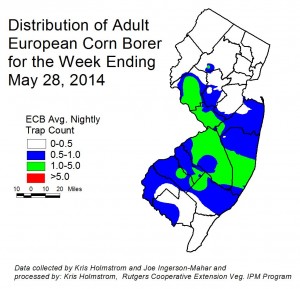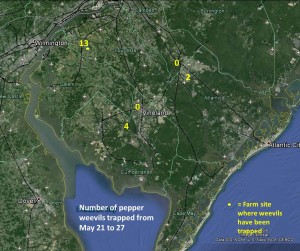Vegetable IPM Report 5-28-14 – Click to View | Download | Print
Maps for the Week
-European Corn Borer Population Map
-Pepper Weevil Trap Catch MapTopics for the Week
- Sweet Corn
- Cole Crops
- Peppers
- Tomatoes
- Pepper Weevil Report
- BMSB
Sweet Corn
European corn borer (ECB) adult catches have increased in most blacklight traps over the past week. The most consistent catches range from Hunterdon County south and east through Atlantic County (see ECB map). This trend should continue, with increased catches moving northward over the next two weeks. Numbers may intensify in the southern part of the state for another week as well.
As yet, larval infestations in sweet corn have not been detected in central and northern counties, but may be present in southwestern NJ. As of Tuesday, adult female moths were seen depositing eggs in whorl corn as far north as Middlesex County. Within a week, feeding should be apparent on these plants.
Consider treating if 12% or more plants exhibit the characteristic “shot-hole” type feeding on leaves. It is not too early to consider ECB management tactics on later stage sweet corn. Remember to make a full-tassel application to control ECB larvae as they leave the tassel and travel down the stalk to re-enter the plant near the ear shank. This last application is often critical to controlling ear infestations from ECB. Often, early sweet corn plantings suffer from “split set”, in which germination does not occur in a uniform fashion. The result is a planting where all plants do not reach full tassel at the same time. This situation may require an extra tassel spray if there are several days difference in the time full tassel is reached on a significant number of the plants.
| The highest nightly ECB catches for the previous week are as follows: | |||||
| Clinton | 4 | Folsom | 2 | Medford | 2 |
| Georgetown | 4 | Indian Mills | 2 | Sergeantsville | 2 |
| Chester | 2 | Lawrenceville | 2 | Crosswicks | 1 |
| Downer | 2 | Matawan | 2 | Elm | 1 |
A single corn earworm moth (CEW) was captured in a blacklight at Woodstown in Salem County this past week. These scarce individual moths typically do not represent a threat, as silking sweet corn is not present. As the first plantings go to silk, should we capture CEW even at low numbers, the danger of infestation will be significant. As silks begin to appear, pay close attention to CEW catches in local blacklight traps, and treat silking plantings accordingly.
Cole Crops
Heavy egg laying by imported cabbage butterflies (ICW) continues. Infestations of this pest have been found in the central counties, and are certainly present further south. Scout plantings weekly. Check 5 consecutive plants each in 10 random locations throughout the planting, paying particular attention to the innermost leaves where ICW often feed. Consider treating if caterpillars are found on 10% or more plants that are in the 0-9 true leaf stage. From 9-leaf to the early head stage (in broccoli, cauliflower and cabbage) infestations up to 20% may be tolerated. Once heads begin to form, a 5% threshold should be observed to protect the marketable portion of the plant. For leafy greens such as collards and kale, 10% plants infested is the threshold throughout.
Crucifer flea beetle is active on many plantings, particularly when conditions are warm. When scouting cole crops for caterpillar pests, check for the presence of flea beetles. Consider treating if flea beetles are present on 50% or more plants, and feeding injury is evident on the plants. Be sure to monitor newly emerged or transplanted fields for the presence of this pest. In general, plants like arugula and mustard (those with a “hotter” flavor) are more favorable to flea beetles.
Peppers
Pepper transplants are now going into fields. At the same time, the first ECB flight is increasing. Be sure to scout fields regularly for the presence of ECB egg masses. If two or more egg masses are found in a 50 plant (two leaves/plant) sample, consider treating even if no fruit are present. In the absence of fruit, ECB larvae will bore into the central stem, topping the plant. This will result in the loss of crown fruit on infested plants. Generally, where blacklight trap catches average one or more ECB per night (blue and green areas on the ECB map) and fruit are greater than ½” in diameter, insecticides are warranted. See the 2014 Commercial Vegetable Production Recommendations for materials useful in controlling ECB.
Tomatoes
Many early tomato plantings are now in the field. Pruning and tying of plants is on-going. Remember that any event that results in contact with the plant causes numerous injuries to them – this includes hail injury. (See Dr. Wyenandt’s recent post regarding the hail event in southern NJ). While these injuries heal, they serve as avenues of entry for bacterial pathogens that may be present either on the plants or in the field. Serious bacterial pathogens of tomato include bacterial leaf spot and bacterial canker. Both can result in unmarketable fruit, and canker can kill plants prior to the production of fruit if the infection occurs early enough. Timing and rates for applications of copper and/or the plant defense activator Actigard are detailed in the 2014 Commercial Vegetable Production Recommendations. These products provide some suppression of bacterial pathogens. It is critical, however, that spread of bacterial organisms be limited as much as possible. Avoid working in fields when plants are wet. When work is to be done in more than one planting, always work from youngest to oldest plants. This prevents workers from transporting bacteria to younger plants, where infections can result in increased crop loss. Remember that the earlier a plant is infected by a bacterial pathogen, the more likely it is to produce unmarketable fruit.
Two-spotted spider mite (TSSM) infestations have recently been discovered in high tunnels in Hunterdon County. TSSM feeding results in small white pin-spots on the upper leaf surface. Mites are actually underneath leaves. These pests can increase dramatically in the warm, dry environment of the tunnel. Check 5 plants each in 5 separate locations in the tunnel. Inspect the entire plant, and be sure to check the underside of leaves that display the whitish mite feeding. If mites are found, it is best to immediately treat. TSSM is much more easily managed, when the problem is addressed at low levels. If allowed to spread throughout the tunnel, TSSM will be much more difficult to control. See the 2014 Commercial Vegetable Production Recommendations for materials that are labeled for use in greenhouse structures. It may be possible to deploy predatory mites such as Neoseiuilus falacis in the tunnel to limit TSSM populations. This and other TSSM predators may be purchased from bio-control suppliers such as Koppert. The main drawback of this strategy is that predatory mites generally have much lower tolerance for heat than TSSM. Therefore, if outside weather is routinely exceeding 80°F, and the tunnel temperature is exceeding 85°F during the day, it is unlikely that predatory mites will survive long enough to have a significant impact on TSSM.
Aphid populations have also begun to appear both in the field and in high tunnel tomatoes. These pests often form colonies beneath the surface of leaves and near growing points on the plant. While the plants consist primarily of vegetative growth without fruit, aphids are largely an insignificant pest. If no broad spectrum insecticides are used on the plants, the aphids generally are decimated by predators and parasites before becoming an economic problem. Should aphid populations increase to a degree that their droppings are accumulating on the surface of developing fruit, an insecticide that specifically targets these pests may be necessary. See the 2014 Commercial Vegetable Production Recommendations for materials that are labeled for aphid control in tomatoes. Avoid broad spectrum insecticide classes such as synthetic pyrethroids as much as possible.
Pepper Weevil Report
Pepper weevils continue to be trapped at/near produce handling facilities, however no weevils have been trapped at two of these locations (see Pepper Weevil Trap Catch Map). Although one pepper field had weevils, the population may not be established. One weevil was trapped in a tomato field in the Swedesboro area – weevils are not harmful to tomatoes.Pepper fields that are close to the produce handling facilities are the most vulnerable to infestation. These fields, at least, should be sprayed at first bloom/fruit set. The goal is to prevent the weevils from becoming established.
Brown Marmorated Stinkbug (BMSB)
No BMSB individuals were captured in light traps this past week. As adult captures increase to 5/night in parts of the state, maps will be produced to show where activity is highest. Information on scouting, crop injury and control will also be included.
All current and archived European corn borer, corn earworm and brown marmorated stink bug population maps are also available for viewing @ http://tinyurl.com/njaes-ipm-maps



